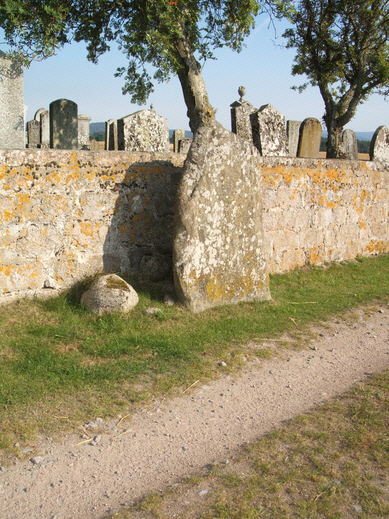Main Content
St Walloch
The higher reaches of the Don valley, at least as far west as Corgarff, have been inhabited since Bronze Age times. Lower down the valley, a tributary of the Don, the waters of the Buchat, have created a fine and fertile glen to the north of the ancient holy mountain of Strathdon - Ben Newe - called Glenbuchat.
In the far north of Glenbuchat we see a solitary glimpse of the presence of the Early Church in the place-name Kilvalauche, located somewhere in the forest of Badeneoin (NGR NJ 333190), which is mentioned in a charter of 1507.1 This name - Kilvalauche - can hardly mean anything else than 'the church of St Walloch'. From the same document we learn that Culbalauche, 'St Walloch's retreat', was in the same neighbourhood, although this does look a lot like Kilvalauche noted above. Prior to 1473 the Chapel of Glenbuchat was a dependancy of the parish church of Logie-Mar, its suggested link with St Walloch being thus given the strongest argument conceivable in its favour. Final confirmation seems to be obtained from a statement that St Walloch, in addition to his other church foundations, at Dunmeth in Glass and at Balvenie, had a church site in Strathdon.2
We have no trustworthy guidance as to the date of St Walloch's labours. The Aberdeen Breviary places him in the fifth century, while Camerarius fixes his death in the year 733. In the Breviary we are given an interesting account of St Walloch's mode of life, coupled with a highly unflattering picture of the folk he strove to convert:-
"He preferred a poor little house, woven together of reeds and wattles, to a royal palace. In this he led a life of poverty and humility, on all sides shunning the dignities of the world, that he might achieve to himself a higher reward in heaven. But the race whom he preferred to convert to the faith of Christ, and whom actually by his preaching and exhortation he did convert, no one would hesitate to describe as fierce, untamed, void of decency of manners and virtue, and incapable of easily listening to the word of truth, and their conversation was rather that of the brutes that perish than of men."

Above: St Walloch's Stone (the Walla Stone).
St Walloch is said to have been among the last of the missionaries to be sent to the north-east of Scotland from St Ninian's centre at Whithorn (Candida Cassa). However, though he is familiarly called "Walloch the foreigner", his origin and nationality are actually unknown. At his foundation at Logie-in-Mar there stands, at the gate, just outside the churchyard, a rough monolith about 5' 6" tall, known as Walloch's Stone. Walloch's Fair was a popular event in the district and was held on his Feast Day - 29th January.
One source gives us a very different history.3 It says that the saint, whose name appears in a corrupted form as Wolok, latinised as '"Volocus", is believed to be Fáelchú, 13th abbot of Hy (Iona) from 716 till 724. He sprang from the race of Conall Gulban, the ancestor of the famous lineage of Cenél Conaill which included several of the saints of Ireland, including St Columba himself. Born in 664, Fáelchú was seventy-three when, on Saturday, 29th August, he was called to the chair once occupied by St Columba. Indeed, it has been thought that Fedlimid, 14th abbot of Hy (722-?), was an assistant abbot appointed to take care of business because of Fáelchú's great age.
Walla Kirk (Walloch's Church), as the church of Dunmeth in Glass was called, stood in its burying-ground on the bank of the River Deveron, but is now represented only by some mounds. It was held in superstitious regard even in post-reformation times for in 1648 the ministers of Strathbogie "ordanit to censure all superstitione at Wallak Kirk". About a hundred yards east of the church once flowed St Wallach's Well. On its margin lay a stone with a hollow in it, into which pins were dropped by health-seekers as offerings to the saint. As the result of agricultural improvements the spring has been drained, and the water gushes out further down the bank, and the stone now lies unheeded. In the neighbourhood of the graveyard, where a foot-bridge spans the Deveron, is Wallach Pot, a pool in the river said to be about fourteen feet deep. Fully a quarter of a mile further along the river bank is a long, trough-like hollow in the rock, known a St Wallach's Bath. Sickly children used to be dipped in its water in search of a cure. Pieces of their clothing and also coins were thrown into the bath as offerings. If there is any truth in the tradition that St Wallach's Hermitage stood on a neighbouring mound then it points to the Saint having laboured in the locality for some years before he then became abbot of Hy.
References.
1. Registrum Magni Sigilli, 1424-1513, No. 3159. Return.
2. Camerarius, David (1631) De Scotorum Fortitudine , p.94. Return.
3. Mackinlay, J.M. (1914) Ancient Church Dedications in Scotland:Non-Scriptural, p. 143. Return.
small(transp).png)
